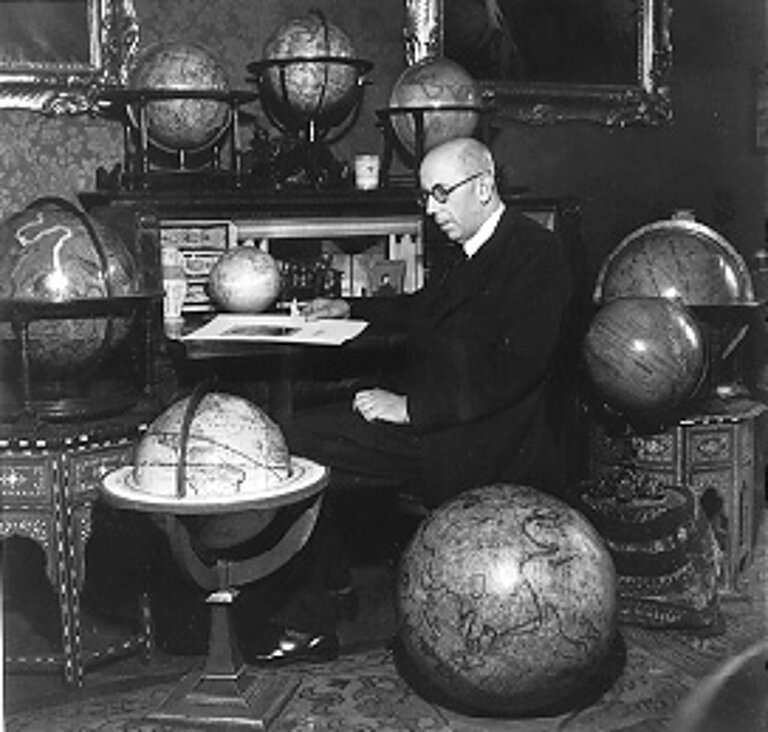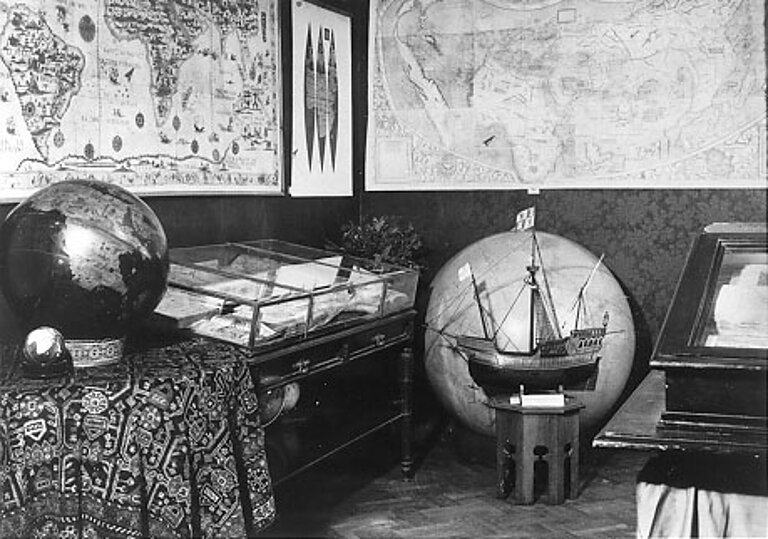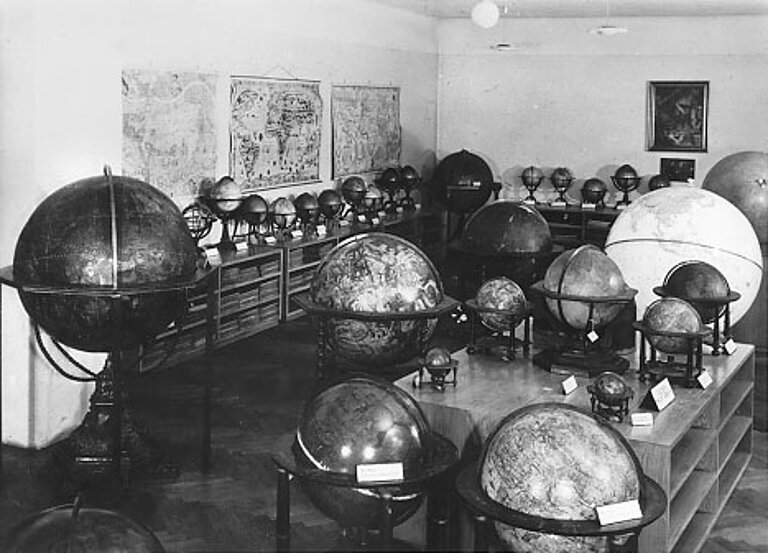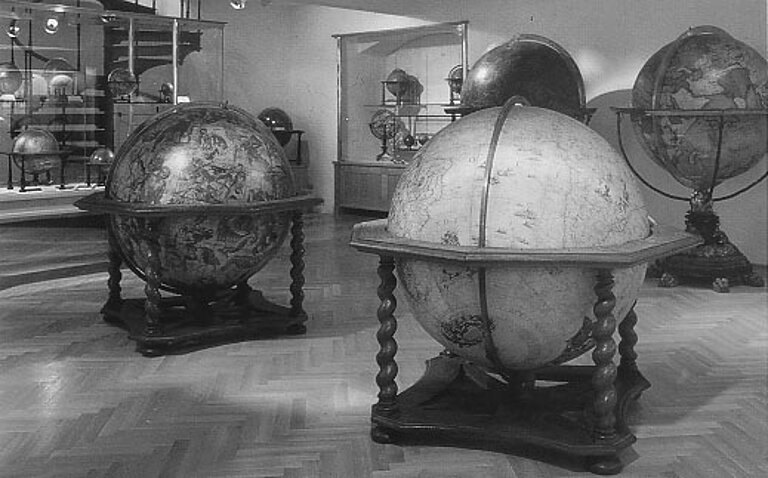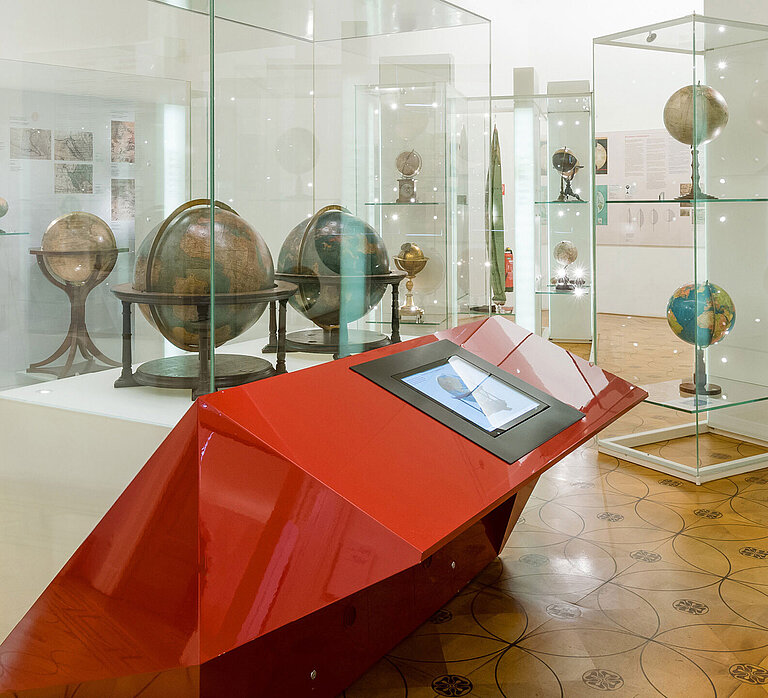The history of the Globe Museum
The Globe Museum of the Austrian National Library is the only one of its kind in the
world. Nowhere else do you have the opportunity to see terrestrial and celestial globes,
lunar and planetary globes, planetaria, telluria and lunaria in their original condition,
and to study the development of globe manufacture, as well as changes in cartographic
and cosmographic knowledge. It is the fact that this collection is so focused yet diverse
that is responsible for its appeal, its cultural-historical importance and its
international scientific reputation. The museum, which is now 60 years old, is constantly
being expanded: It currently houses over 820 objects, thereof 250 are shown at the
permanent exhibition. It is the only institution where globes and globe-related
instruments are acquired, studied and presented to the general public.
According to written sources, there were globes in the imperial Court Library even at
the start of modern times, but over the centuries these have disappeared. For example,
there was supposed to have been a beautiful armillary sphere here, supported by Atlas,
that was made in about 1535 by Martin Furtenbach for Raimund Fugger. The famous
Venetian globemaker and scholar Vincenzo Coronelli had links with the imperial court
that were not only scientific but also personal. Coronelli gave Emperor Leopold I a pair
of magnificent 110 cm globes which were particularly lavishly decorated and adorned
with a portrait of the emperor and a homage. This and a second, almost identical pair
of globes – once owned by the Holy Roman Emperor Francis I – were included in the
design for the State Hall at the Court Library as early as the beginning of the 18th
century. They were displayed in the most prestigious location, below the central cupola
in the baroque library room.
It is only from the second half of the 19th century that we have sources to confirm the
purchase of globes. In 1875, two globes by Gerard Mercator (1541 and 1551) were
acquired from a private seller, which were at the time – erroneously – thought to be a
unique example that had been owned by Emperor Charles V.
When the Viennese geographer Eugen Oberhummer carried out some research
regarding old globes in Vienna in 1921, the National Library held the following: in
addition to the two giant fire-gilded globes among the statues on the façade of the State
Hall above the western (Gaea with terrestrial globe) and eastern (Atlas with celestial
orb) entrance doors, and the two 110 cm Coronelli pairs, in the State Hall between the
cupola room and the entrance there was a pair of Blaeu globes (Ø 68 cm), in the
meeting room the aforementioned Mercator pair (Ø 41 cm), a terrestrial and a celestial
globe by Gerard Valk (Ø 39 cm) and in the Camera Praefecti a pair of small Blaeu globes
(Ø 34 cm) and two armillary spheres dating from the 18th century. In 1922, these ten
objects were incorporated in the Geographical Collection and remained on the sidelines
during the inter-war years. In 1948, an entry in the Collection Director's annual report
referred to the by now 28 globes as follows: “The globes are among the objects that are
most rarely used.”
It was thanks to Robert Haardt that interest in the globes was rekindled. As a result of
his experience in contemporary globe-making, Haardt began to take a very far-reaching
interest in antique globes and so was responsible for a renaissance in the study of the
instrument. Haardt's undisputed claim to fame lies in his unshakeable belief in the
educational and scientific relevance of the globe.
For Haardt, the globe was not only an interesting object to study and collect from the point
of view of science or art history or craftsmanship – he was also convinced of the
contemporary importance of the globe for research and teaching purposes. Starting
from the idea that the globe – as a true-to-scale, distortion-free, three-dimensional
model – could be adapted for use in making direct measurements of distances, angles
and areas, he began to develop and construct a new type himself. Haardt described
this instrument – which was not attached to an axis, but was mobile and fitted with a
device for measuring distances (in kilometres, degrees and English miles), and also had a
transparent calotte (cap) for directly measuring surfaces and angles – as a “rolling
globe”.
Between the wars, Haardt was already devoting a lot of time and energy to his project
of establishing a globe museum, and even during the Second World War he tried to
push ahead with his undertaking. He collected information about antique globes, maps
and atlases, asked for photographs and pictures and apparently also explored the
options and conditions for borrowing these objects for a globe museum that he planned
to set up in Vienna.
Straight after the end of the war, the globe museum project was revitalised, and now
Haardt found there was a lot of support for it – for example from the university
professor and esteemed specialist in historical geography, Hugo Hassinger, who wrote about the project in very positive terms in publications and also in a memo to the
Ministry of Education. This paved the way for Haardt to set up a “Globusmuseum” in his
private apartment in the 4th district of Vienna (Gusshausstrasse 20).
In the meantime, Haardt had managed to acquire some remarkable globes privately –
the most outstanding being the only known example in the world of a terrestrial globe
by Gemma Frisius (Ø 37 cm, from about 1535). His globe museum grew steadily – partly
with loans from national institutes and organisations and partly with acquisitions
funded by the Ministry of Education. Robert Haardt was a tireless collector of
everything to do with globes – both as actual objects and in their role as symbol,
attribute and decoration: he collected literature, catalogues, pictures and descriptions.
The problematic situation where state-owned objects were kept under private
management, unsecured, in an apartment, led the Republic of Austria to endeavour to
put an end to this legal anomaly and clarify the terms of ownership. Just a few years
after the Second World War there was talk by the Ministry of Education about “placing
the Globe Museum under government control” and having those objects that had been
bought with public funds added to the holdings of the Austrian National Library. Even
though Robert Haardt had a good working relationship with the National Library, it was
only very reluctantly that he parted from “his” collection. On December 2, 1953, the
Ministry of Education decided to entrust the Austrian National Library with taking over
the collection. So, on April 23 and May 5, 1954, the handover of 25 globes, 51 volumes
of reference works, 13 sets of maps and ten portfolios of pictures finally took place. The
official opening of the museum, the only one of its kind in the world – with 63 exhibits
– finally took place on April 14, 1956. In the room that is now the reading room of the
map department, the smaller globes were presented on wooden tables and the large ones
standing on the floor, arranged according to visual and chronological-historical criteria.
During the first thirty years (1956–1986), the museum was able to acquire a further 74
globes. These additions to the collection were only possible thanks to numerous
dedications from private individuals and the state. Of the 74 globes, 42 were gifts to the
museum, 27 were purchased, two were from existing collections at the Austrian
National Library, and three were the result of exchanges.
Even though the Globe Museum moved into new premises in 1970 (it was reopened on
March 7 after having been closed for almost a year), this did not bring either a
significant increase in space or better conditions for displaying the exhibits. The main
advantage was that there was easier access for visitors.
Only once rooms became available in the roof space, between 1983 and 1986, could the
long overdue modernisation work and modifications to comply with current
conservation guidelines be carried out. By removing partition walls and carrying out
extensive refurbishment, three larger rooms were created on two levels, linked by a
spiral staircase. This meant that the entire collection (145 objects) could be displayed
for the first time, in perfect conditions for conservation and so as to serve an
educational purpose. The official opening took place on April 2, 1986. The only fly in
the ointment was the knowledge that there was not enough spare space for the
additions to the collection that were expected to be made.
Visitor numbers were increasing, but could not increase further due to the short
opening hours. On Open Days or the Long Night of Museums, the interest from the
general public was enormous. Thanks to a targeted policy of acquisition and collection,
the collection grew continuously. In 1996, ten years after it opened, the museum had
260 exhibits, and in the following decade they were joined by 200 more. The available
capacity was completely full and many new acquisitions had to be stored in a vault.
Only when the Palais Mollard-Clary in the Herrengasse in Vienna was acquired for the
Austrian National Library and completely redesigned did new prospects open up for the
Globe Museum. For four years – from 2002 to 2005 – the museum was planned, rebuilt,
adapted, an educational concept prepared, an interior design plan and multimedia
presentations developed and, finally, the logistics for rehousing the fragile objects
organised.
The new Globe Museum of the Austrian National Library
On December 1, 2005, the Globe Museum of the Austrian National Library reopened on
the belle-etage of the baroque Palais Mollard in the centre of Vienna.
The museum is divided into a concept-based exhibition area and an object-based
collection where researchers can study and learn about the treasures of the museum (by
prior appointment). In the museum's permanent exhibition, specific themes are used to
present globes both as a particular kind of cartography and as valuable objects of
enormous artistic beauty and craftsmanship. In addition to basic information about
globes as models of the world, the presentation focuses on the history of globes, their
structure and construction, the range of data and information shown on globes, but
also on special types of globes, as well as issues relevant to cultural history such as the
use of globes and their popularity.
A special room is dedicated to the most famous globe designer and maker of the
baroque era, the polymathic scholar Vincenzo Coronelli from Venice and his works. In
addition to the huge Coronelli globes (110 cm in diameter), another outstanding
highlight of the collection is the pair of globes by Gerard Mercator dating back to 1541
(terrestrial globe) and 1551 (celestial globe). In the so-called “Golden Cabinet” dating
from the end of the 17th century, with wall paintings attributed to Andrea Lanzani,
visitors can see instruments related to globes (armillary spheres, planetaria and
telluria).
A special attraction is the virtual globe created in 2005. Located right next to the
original (terrestrial globe by Gerard Mercator), this digital 3D facsimile now offers
visitors the opportunity to turn and enlarge the Mercator globe, which they are not
allowed to touch, on a touchscreen. They can overlay current geographical data (such as
coastlines) and so compare the geographical knowledge of the 16th century with the
reality today.
To symbolise the wide range of objects in the Globe Museum, there is a round, glass
construction that fills a complete room. This features an impressive and beautifully
presented collection of “Globes from all over the world”; in one section, lunar
and planetary globes are displayed and explained. Another special feature of this
unique museum is what is called the “Collectors' Cabinet”. Four showcases display
representative items from important private collections in Vienna, thus documenting
four very personal ways in which people have approached the phenomenon of the
globe as a collector's item. This is also the room where the oldest globe in Austria, the
terrestrial globe by Gemma Frisius dating from 1536, is displayed.
The themes running through the collection are conveyed not only through the original
objects themselves but also through the various focus areas, accompanied by texts in
German and English, graphical images and close-up photographs. The rear of the
showcases and a number of wall panels are decorated with numerous enlarged illustrations showing sections of the maps on the globes, in order to draw visitors'
attention to the details and encourage them to make their own discoveries on the
globes that are on display.
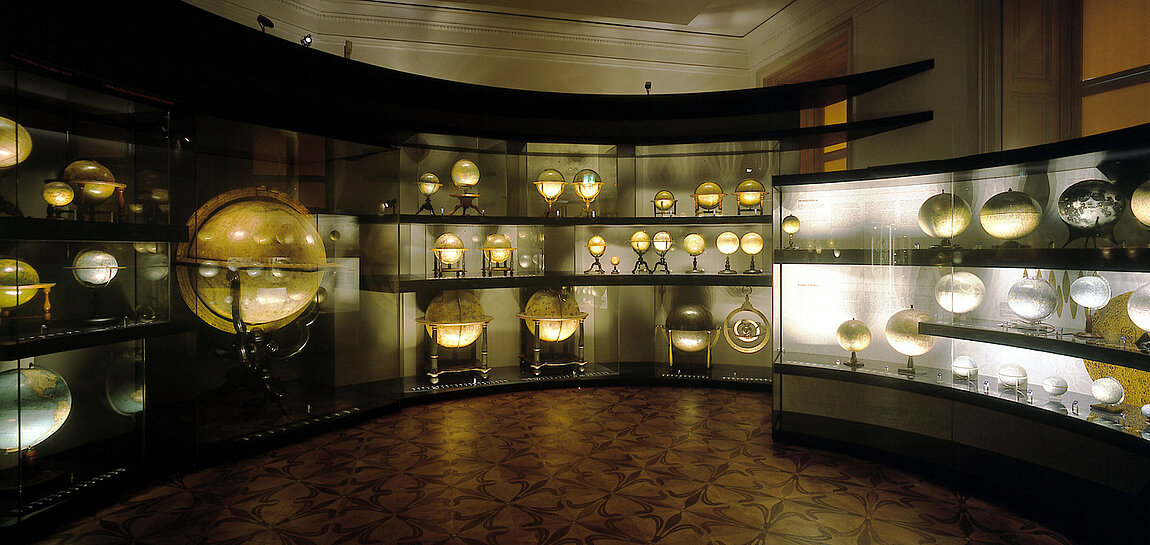
As part of the educational work of the museum, there are multimedia applications
explaining scientific aspects. These were jointly designed and produced by the Globe
Museum and the Institute for Geography and Regional Research at the University of
Vienna. The presentations that can be downloaded on to the interactive displays enable
visitors to approach the subject of the globe in a contemporary way.
In addition to the introductory information shown on a large screen, the subject can be
studied in greater depth above all through interactive presentations (on, for example,
the planation of the earth's surface and the apparent dome of the heavens, and
comparing the principles behind the construction of maps and globes) and the
multimedia displays which impart both basic facts and more detailed knowledge of
globe studies. The highlight of these digital applications, and a big draw for the public,
is undoubtedly the virtual globe, which can be enlarged, turned and compared with
current geographical knowledge. Altogether, visitors to the Globe Museum have the
chance to see 200 objects owned by the Austrian National Library and 50 items on loan.
Longer opening hours, informative guided tours and the tremendous interest from the
public in the new museum have resulted in a huge increase in visitor numbers.
The founding of the Globe Museum filled an important gap in scientific and cultural
history. Its rapid development from modest beginnings, its extensive and extremely
valuable acquisitions – often thanks to generous sponsors – and the popularity of
the new museum clearly demonstrate the success of its first 60 years.
Text by: Mag. Elisabeth Zeilinger

